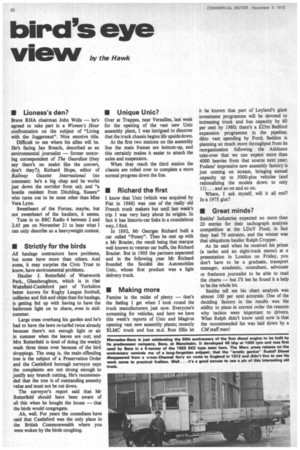bird's eye
Page 34

If you've noticed an error in this article please click here to report it so we can fix it.
view bytimHawk • Lioness's den?
Brave RHA chairman John Wells — he's agreed to take part in a Women's Hour confrontation on the subject of "Living with the Juggernaut". Nice emotive title.
Difficult to see where his allies will be. He's facing Ian Breach, described as an environmental journalist — former motoring correspondent of The Guardian (they say there's no zealot like the convert, don't they?); Richard Hope, editor of Railway Gazette International (no comment: he's a big chap and he works just down the corridor from us); and "a hostile resident from Ditchling, Sussex" who turns out to be none other than Miss Vera Lynn.
Sweetheart of the Forces, maybe, but not sweetheart of the hauliers, it seems.
Tune in to BBC Radio 4 between 2 and 2.45 pm on November 21 to hear what I can only describe as a heavyweight contest.
• Strictly for the birds
All haulage contractors have problems, but some have more than others. And some, it may surprise the Civic Trust to know, have environmental problems.
Haulier J. Butterfield of Weetworth Park,, Glasshoughton, which is in that Wakefield-Castleford part of Yorkshire better known for Rugby League football, collieries and fish and chips than for haulage, is getting fed up with having to have the bathroom light on to shave, even in midsummer.
Large trees overhang his garden and he's had to have the lawn re-turfed twice already because there's not enough light or air in summer when the leaves are out; and Mrs Butterfield is tired of doing the weekly wash three times over because of the bird droppings. The snag is, the main offending tree is the subject of a Preservation Order and the Castleford borough surveyor says the complaints are not strong enough to justify any branch cutting, He's recommended that the tree is of outstanding amenity value and must not be cut down.
The surveyor's report said that Mr Butterfield should have been aware of all this when he bought the house — that the birds would congregate.
Ah, well. For years the comedians have said that Castleford was the only place in the British Commonwealth where you were woken by the birds coughing.
• Unique Unic?
Over at Trappes, near Versailles, last week for the opening of the vast new Unic assembly plant, I was intrigued to discover that the truck chassis begins life upside down.
At the first two stations on the assembly line the main frames are bottom-up, and this certainly makes it easier to attach the axles and suspension.
When they reach the third station the chassis are rolled over to complete a more normal progress down the line.
• Richard the first
I know that Unic (which was acquired by Fiat in 1966) was one of the really old French truck makers but until last week's trip I was very hazy about its origins. In fact it has historic-car links in a roundabout way, I find.
In 1892, Mr Georges Richard built a car called "Poney". Then he met up with a Mr Brazier, the result being that marque well known to veteran car buffs, the Richard Brazier. But in 1905 the partners separated and in the following year Mr Richard founded the Societe des Automobiles Unic, whose first product was a light delivery truck.
• Making more
Famine in the midst of plenty — that's the feeling I get when I look round the truck manufacturers just now. Everyone's screaming for vehicles, and here we have this week's reports of Unic and Magirus opening vast new assembly plants; recently BLMC truck and bus m.d. Ron Ellis let it be known that part of Leyland's giant investment programme will be devoted to increasing truck and bus capacity by 60 per cent by 1980; there's a £25m Bedford expansion programme in the pipeline; ditto vast spending by Ford; Seddon is planning so much more throughput from its reorganization following the Atkinson take-over that we can expect more than 4000 heavies from that source next year; Fodens' impressive new assembly factory is just coming on stream, bringing annual capacity up to 5000-plus vehicles (and rationalizing the models down to only 11) ... and so on and so on.
Where, I ask myself, will it all end? In a 1975 glut?
• Great minds?
Smiths' Industries expected no more than 20 entries for their tachograph analysis competition at the LDoY Final; in fact they had 79 entrants, and the winner was that ubiquitous haulier Ralph Cropper.
As he said when he received his prizes (a tacho and an eight-track stereo) at a presentation in London on Friday, you don't have to be a graduate, transport manager, academic, consultant, advocate or freelance journalist to be able to read the charts — but I'll bet he found it a help to be the whole lot.
Smiths tell me his chart analysis was almost 100 per cent accurate. One of the deciding factors in the results was the ability to place in correct order the reasons why tachos were important to drivers. What Ralph didn't know until now is that the recommended list was laid down by a CM staff man!
























































































































